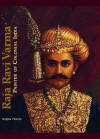|
saLT |
the-south-asian Life & Times April - June 2010 |
|
|||
|
Art Travel Women
& Politics
Profile Comment Future Predictions
|
|
||||
|
Raja Ravi Varma -
PAINTER OF COLONIAL INDIA Reviewed by Gautam Acharya
(1848-1906) Born to a learned Brahmin father and a Kshatriya mother who was an accomplished poet – Ravi Varma was one of four siblings – three boys and a girl – and grew up in a matrilineal household, which afforded him a close, yet distant, view of women. His orthodox and classical education, usual for children of his background, gave him an understanding and appreciation of Malayalam, Sanskrit, astrology, Ayurvedic medicine, architecture, drawing, painting, music and classical literature. His younger brother Raja Raja Varma and sister Mangala were both talented painters as well. The brothers often produced joint works – and remained together for 27 years – travelling and working – until the death of the younger sibling in 1905. Heartbroken at his brother’s sudden death, and unable to recover from this loss, Ravi died the following year - in1906. In his lifetime Ravi worked on hundreds of commissioned works for nearby and distant rulers who had heard of his magic with oils and a paint brush. Some created special galleries in their palaces to display his work. His portraits captured not only the likeness of the sitter, but the entire ambience and the lifestyle of the time – the details of the fabric, the style of clothes, the fashion, the jewels, the artefacts, furnishings and furniture – all were an important part of his paintings. Similarly, his intuitive understanding of stories from epics and puranas helped him create a theatre of sorts on his canvas. Ravi Varma became even better known when he set up the Ravi Varma Press in 1894 in Bombay. His affordable prints of the Hindu deities made him accessible to middle-class families, while his phenomenal portraits and mythology-inspired paintings brought him royal patronage and commissions from many states, small and large, such as Pudukottai, Aundh, Bhavnagar, Mysore, Baroda and Hyderabad. He was a man of multiple styles. In his mythological paintings, one can see the drama he is trying to create on his canvas, as in the series on ‘Shakuntala’. In his portraits, he treats his subjects with finesse. His female subjects are dignified, beautiful, and sensitive – with a regal bearing and royal demeanour. He captures the details of their intricate brocades and jewels, or even the simple task of tying a strand of jasmine around the hair, with a clarity that defies digital photography. The use of oils and ‘realism’ was new at the time in the Indian art world. The illustrations are of very high quality – though some are repeated several times. Some of the paintings reproduced in the book have not been seen before – which makes it a very rare treasure. The title ‘Raja Ravi Varma – Painter of colonial India” is a trifle misleading. It suggests to some, that Ravi Varma painted what was colonial – which could not be further from truth – and one is certain that it was not the intention of the author to portray him so. Ravi Varma’s art was steeped in tradition and mythology. Rupika Chawla's lavishly produced and engaging book is a labour of love. She collected her material, over the years, from museums, archives, and private collections in different locations within India. What Rupika has put together are memories of a bygone era. A conservator of paintings, she has restored several Ravi Varma paintings at her studio in Delhi. Together with artist A. Ramachandran she organized the exhibition on Raja Ravi Varma in 1993 at the National Museum, Delhi, which brought about a strong revival of the artist and his work. ‘Raja Ravi Varma –Painter of Colonial India’ is a dream collection of paintings by Raja Ravi Varma who has inspired generations of painters in India. The accompanying text is a highly readable and engaging account of palace culture, Travancore in particular, intra-family relationships within a conservative and tradition-bound community, and of course the life and times of Raja Ravi Varma. It leaves one spell-bound. Orders for
the book can be placed with Mapin at
mapin@mapinpub.com
|
|||||
|
Copyright © 2000 - 2010 [the-south-asian.com]. Intellectual Property. All rights reserved. |
|||||
